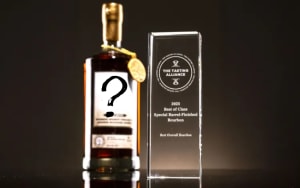Old Potrero rye whiskey has a story that’s hard to beat. It’s got a rich flavor, a fascinating history, and a claim to fame as one of the first craft whiskeys in America. Yet, despite all that, it’s still flying under the radar for many whiskey lovers. While other brands grab the spotlight, Old Potrero quietly sits in the background, waiting for people to discover what it’s all about. So why hasn’t this trailblazing whiskey gotten the attention it deserves? Let’s dive into its journey—from its San Francisco roots to its struggles and its hopes for the future.
A Vision Born in San Francisco
The tale of Old Potrero starts with a guy named Fritz Maytag. If that name sounds familiar, it’s because he’s tied to the famous Maytag appliance family. But Fritz wasn’t content just living off his inheritance. Back in 1965, he took a big risk and bought Anchor Brewing, a struggling San Francisco brewery on the brink of shutting down. He turned it around, making Anchor Steam beer a name people still recognize today. That move put him ahead of the curve, predicting the craft beer boom that would hit years later.
By the early 1990s, with the brewery doing well, Fritz set his sights on something new: whiskey. He didn’t just want to make any whiskey, though. He wanted to bring back the kind of rye whiskey early American settlers might have sipped. To figure out how, he dug into history books at the Library of Congress, learning about colonial distilling. What he found was that rye was the go-to grain back then, and he decided to make a whiskey that honored that past. He settled on using 100 percent malted rye—something almost no one was doing at the time—and distilling it in a copper pot still, a method that had pretty much disappeared in the U.S.
Fritz tapped Bruce Joseph, one of his brewers at Anchor, to help bring this idea to life. They started small, working out of a cramped basement at the brewery on Potrero Hill. The first batch of Old Potrero went into barrels in 1994, years before craft whiskey became a thing. At that point, American whiskey was in a slump—rye especially. In 2009, only 88,000 cases of rye were sold nationwide, and none of them were made from malted rye like Old Potrero. Fritz was betting on a revival that wouldn’t kick off for another decade.
Crafting Something Unique
Making Old Potrero wasn’t a slapdash effort. Fritz and Bruce put a ton of thought into it. They didn’t just buy a still and start messing around—they researched, tested, and tweaked until they got it right. The 100 percent malted rye mash gave the whiskey a flavor all its own—rich, complex, and a little chewy, kind of like a hearty craft beer. Bruce remembers how excited they were when they first tasted it. It wasn’t just different for the sake of being different—it was good, really good.
They played around with barrels, too. At first, they used a mix of new charred oak, new toasted oak, and even some used barrels. Over time, they adjusted things based on how the whiskey turned out. Bruce says they eventually stopped using old barrels, but years later, they realized that was a mistake—those whiskeys aged into something amazing after a long wait. Fritz treated the process like winemaking, using high-quality oak barrels and letting each batch have its own personality instead of forcing them all to taste the same. He even dreamed of seeing Old Potrero served in fancy restaurants, right alongside fine wines.
When the first bottles hit shelves in 1996, after just 13 months of aging, people noticed. Chefs and restaurant owners in the Bay Area loved it, tying it into the local food movement. A big-name beer and whiskey writer, Michael Jackson, gave it a thumbs-up, too. That first release—only 1,448 bottles—sold out fast. But here’s where things got tricky: they couldn’t make enough to keep up.
Too Small to Keep Up
The distillery was tiny. It started with just one little 250-liter still in the brewery basement. Even when they added more stills, they were stuck in that small space. By the late 1990s, they were filling about 75 barrels a year. That doubled to 150 by 2004, but it still wasn’t much compared to what was coming. Craft whiskey started taking off in the late 2000s, with new distilleries popping up everywhere. People were suddenly thirsty for small-batch spirits, and Old Potrero couldn’t grow fast enough to meet the demand.
Fritz was careful about how he sold those early batches. He didn’t want to run out, so he spread them out to select spots, mostly in San Francisco. Bruce thinks they might have been too cautious. By the time craft whiskey really exploded, Old Potrero wasn’t the shiny new thing anymore. Other brands, with bigger production and flashier marketing, stole the show. “Maybe if we’d scaled up sooner, we could’ve kept the momentum going,” Bruce says.
A Flavor That Stands Out
As rye whiskey made a comeback, Old Potrero got left in the dust. Around 2010, a lot of the new ryes hitting the market came from a big distillery called MGP, known for a sharp, peppery taste from its 95 percent rye recipe. Old Potrero’s malted rye is totally different—smoother, grainier, and less spicy. That uniqueness is a double-edged sword. Nick Madden, a bartender at Elixir in San Francisco, says people are surprised by how good it tastes once they try it. “It’s not what they expect from a rye,” he explains. Locals like it, especially with the Golden Gate Bridge on the label, but not everyone knows its story.
At stores, it’s a similar deal. Brendan Noble, a buyer at The Whisky Shop in San Francisco, says walk-in customers rarely ask for Old Potrero by name. Online, though, it’s a different story—people from all over the country order it. The problem? It’s not always easy to find. Whiskey historian Kurt Maitland points out that unless a whiskey’s got a huge hype factor—like Pappy Van Winkle—people won’t hunt for it. They want to walk into a store, see it on the shelf, and grab it. Old Potrero’s limited reach makes that tough.
A New Shot at the Spotlight
Things might be looking up for Old Potrero, though. In 2010, Fritz sold Anchor Brewing and Distilling. A few years later, the company split—the beer side went to Sapporo, and the spirits side became part of Hotaling & Co. That shift gave Old Potrero a boost, with better marketing and distribution behind it. In 2020, the distillery moved to a new spot on Pier 50, with a massive 2,900-gallon still. Last year, they filled 400 barrels—a small number compared to big brands, but a big step up for them. With room to grow, they’re ready to make more if people start asking for it.
Bruce, now retired but still tied to the brand as master distiller emeritus, hopes Old Potrero gets its due. He believes it helped kickstart the craft whiskey wave back in the ‘90s, when American whiskey was stuck in a rut. “We had some part in getting people interested again,” he says. Plus, Fritz’s focus on top-notch oak barrels—air-dried and hand-charred—set a standard that even big distilleries copy now.
Will Old Potrero Finally Shine?
So, will Old Potrero ever get the recognition it deserves? It’s got everything going for it: a killer origin story, a standout flavor, and a legit claim as America’s first craft whiskey. But it’s been held back by bad timing, small production, and a crowded market. Now, with a bigger distillery and more support, it’s got a chance to break through. Whether it’s sipping it at a San Francisco bar or ordering it online, people who try Old Potrero tend to love it. Maybe, as it nears its 30th birthday, this hidden gem will finally step into the light—and stay there.




